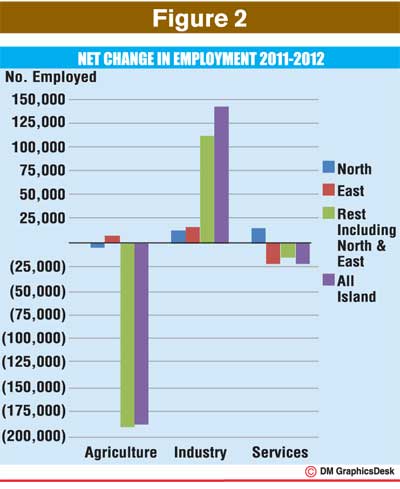Reply To:
Name - Reply Comment
 The Sri Lankan economy is reported to have grown by 6.4 percent in 2012. This was less than what was hoped, but still a robust level of growth. In 2010 and 2011 growth was an extremely healthy 8 percent and 8.2 percent. The puzzle is that the growth in the economy is not being reflected in the jobs; this is true when tracking growth ever since 2005. A closer look is needed at this puzzling phenomenon of jobless growth.
The Sri Lankan economy is reported to have grown by 6.4 percent in 2012. This was less than what was hoped, but still a robust level of growth. In 2010 and 2011 growth was an extremely healthy 8 percent and 8.2 percent. The puzzle is that the growth in the economy is not being reflected in the jobs; this is true when tracking growth ever since 2005. A closer look is needed at this puzzling phenomenon of jobless growth.
It’s jobs not unemployment that tell the story
The advertised unemployment figure has been falling over the last decade and is down to 4 percent in 2012. But it’s possible to have falling jobs and falling unemployment at the same time. This is because of the way economists measure the labour force—only as those who are “looking for work”. The unemployed are the fraction of the labour force that can’t find work.
Therefore, if people get fed up and stop looking, because they have lost hope, unemployment falls. In a growing economy, usually, the labour force expands, because income expectations and hope expands. But in Sri Lanka the reverse seems to be true. The labour force consisted of 8.55 million in 2011 but only 8.46 million in 2012. In other words, 195, 000 people gave up on looking for work. Demographic ageing has not reached the stage where the number retiring should exceed the numbers finishing education, so the puzzle deepens; and jobs remain the problem.
The Sri Lankan economy despite the growth trend had 68,222 fewer jobs in 2012, than in 2011.

Sectors and Industries
Drilling deeper and disaggregating the numbers by sectors and industries locates the problem more specifically, though the reasons remain elusive. The chart below compares sector growth with the employment generated by that sector. On a breakdown of sector the jobless growth emerges in Agriculture and Services, but not in Industry (see figure 1 and 2).
The agriculture sector is particularly startling. It grew by 5.8% last year but shed 7.5 percent of its workers. The number of skilled agriculture and fisheries workers employed fell by 144,000 last year.
The Central bank Annual Report 2012 reports that “The trade and hotels; transport, storage and communication sub sectors contributed positively in generating employment in the Services sector”. But there is some obfuscation through aggregation. In fact employment in “hotels and restaurants” fell by 7.9 percent in 2012 while very curiously the sub-sector is reported to have grown by 21 percent; with tourism said to have passed the landmark of one million tourist arrivals and exceeding US dollar 1 billion of earnings, the highest recorded in a single calendar year.
Post conflict area Vs the rest
The numbers can also be looked at from a regional perspective, especially since the post-conflict zones of the North and East are reported to have grown much faster than other regions. It is only in Industry that jobs increase both in the North and East, by approximately 13,000 and 17,000 respectively.
 The Northern Province sees a decrease of 4,590 agriculture jobs and an increase of 15,702 jobs in services. The Eastern Province sees an increase of 7,370 agriculture jobs and a decrease of 21,693 jobs in services. Post conflict areas are, as a percentage of their existing jobs, making larger improvements or smaller decreases than the rest of the Island; but are reflecting the same basic problem where job creation is at odds with reported growth.
The Northern Province sees a decrease of 4,590 agriculture jobs and an increase of 15,702 jobs in services. The Eastern Province sees an increase of 7,370 agriculture jobs and a decrease of 21,693 jobs in services. Post conflict areas are, as a percentage of their existing jobs, making larger improvements or smaller decreases than the rest of the Island; but are reflecting the same basic problem where job creation is at odds with reported growth.
Public sector bucking the trend
While jobs are falling in the economy, they are increasing in the Public Sector: which shows a total increase of almost fifty thousand jobs from 2011 to 2012. While job creation or job loss is fairing a bit better in the North and East, than in the rest of the economy not quite so with public sector jobs. In the two provinces combined public sector jobs fell by 12,000, driven by a fall of over 23,000 in the East but an increase of about 11 thousand in the North.
More questions than answers
Growth in output that is faster than growth in employment can be seen as positive over a long term when the difference can be attributed to increased productivity and increased incomes. But decreasing jobs in a growing economy, especially one with a low level of technology, does not make sense.
One problem could be the quality of data on growth and employment. If the error margins are high, then it could be that growth and job reductions have been greatly over-estimated in the last year. However, this cannot be a one-off problem, because checks reveal that the jobless growth phenomenon is evident through a much longer time period as well.
Isolating by industries and sectors, post-conflict areas and the public sector, as done here, serves to further deepen the puzzle. The question we began with is “where are the jobs”, and disaggregating the numbers we have ended up with even more questions than answers. Could it be, that in Sri Lanka, “something is rotten in the state of economic data”?